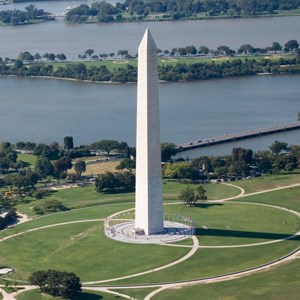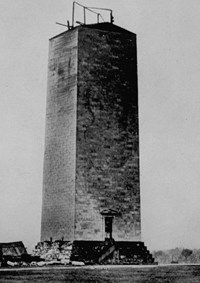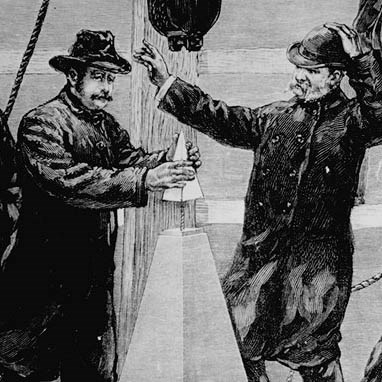History and Culture - Washington Monument (U.S. National Park Service)

The Washington Monument was the tallest building in the world when completed in 1884.
"First in war, first in peace, and first in the hearts of his countrymen."
George Washington's military and political leadership was indispensable to the founding of the United States. As commander of the Continental Army, he rallied Americans from thirteen different states and defeated the superior military forces of Great Britain. Becoming the first president, Washington set the standard for all subsequent presidents with his superior leadership. The Washington Monument rises above the city that bears his name and serves as a reverent reminder of George Washington's greatness. The monument, like the man himself, remains in no one's shadow.
The Washington Monument, designed by Robert Mills and completed by Thomas Casey and the U.S. Army Corps of Engineers, honors and memorializes George Washington in the center of the nation's capital. The structure was built in two phases: private (1848-1854) and public (1876-1884). Built in the shape of an Egyptian obelisk and a reminder of the timelessness of ancient civilizations, the Washington Monument embodies the reverence, respect, and gratitude the nation had for its most important founding father. When completed, the Washington Monument became the tallest building in the world at 555 feet, 5-1/8 inches.

The first phase of construction of the Washington Monument.
Honoring the father of this country
The geometric layout of Washington's streets and green spaces, originally designed by Pierre L'Enfant, envisioned a prominent location for a monument to George Washington at the intersection of lines running south from the White House and west from the Capitol. In 1833, the Washington National Monument Society, a private organization, was formed to fund and build a monument to the first president that would be "unparalleled in the world." The Society solicited donations and designs for ten years, and in 1845 settled on Robert Mills' design. Mills' design called for the erection of a 600-foot obelisk in the Egyptian style surrounded by thirty 100-foot columns. The project was audacious, ambitious, and expensive, which caused many complications during its construction.
Despite fundraising difficulties, construction of the Washington Monument began in 1848. The cornerstone was laid on July 4 with 20,000 people in attendance, including President James K. Polk, former First Lady Dolley Madison, Eliza Hamilton, widow of Alexander Hamilton, Washington's Secretary of the Treasury, George Washington Park Custis, and future Presidents Buchanan, Lincoln, and Johnson. Builders began work on the blue gneiss foundation, a stepped pyramid 80 feet square. Once the base was completed, builders began erecting the 55-foot 1.5-inch square marble structure above ground at the base, using a system of pulleys, blocks and rigging, as well as a mounted tower to lift and set the stones, propelling the structure skyward. By 1854, the monument reached 156 feet above the ground, but a series of events halted construction.
In 1853, a new group affiliated with the controversial Know-Nothing Party gained control of the Washington National Monument Society in periodic elections for the society's board of directors. The society had always had difficulty obtaining funding, but a change in administration alienated donors and led to bankruptcy by 1854. Without funds, work on the monument slowed. Architect Robert Mills died in 1855. For more than two decades, the monument stood only partially completed, more embarrassing to the nation than honoring its most important founding father. Attempts by Congress to support the Washington National Monument Society failed as attention shifted to the internecine crisis and then the Civil War. Only when the nation began to rebuild did attention once again turn to honoring the man who once united the states in a single purpose.

An aluminum finial is mounted on top of the Washington Monument. When completed in 1884, it became the tallest building in the world, standing 555 feet 5.125 inches tall.
To greater heights
Under a joint resolution passed on July 5, 1876, Congress took it upon itself to fund and construct the Washington Monument. The U.S. Army Corps of Engineers, under the direction of Lt. Col. Thomas Lincoln Casey, was responsible for directing and completing the work. Casey's first task was to strengthen the monument's foundation, which he felt was inadequate for the structure as designed. Over the course of four years, builders carefully reinforced the supports at the base of the foundation to support the enormous weight of the future superstructure.
To continue construction, the masons needed stone. The problem was that the quarry near Baltimore used for the original construction was no longer available after so many years. In search of a suitable option, the builders turned to a quarry in Massachusetts. However, problems quickly arose with the quality and color of the stone, as well as the irregularity of the supply. After laying several layers of stone from Massachusetts, which can still be seen with the naked eye today as brown spots on one-third of the monument, the builders turned to a third quarry near Baltimore, which proved more favorable, and used that stone for the upper two-thirds of the structure. The stone never matched exactly, and today three slightly different colors from the three quarries can be distinguished.
Instead of rising to a height of 600 feet, as Mills had envisioned in the original plan, Casey was persuaded to make the height of the structure ten times the width of the base, meaning that the optimum height of the Washington Monument was 555 feet. Plans for the decoration of the obelisk and ring of columns were discarded in favor of the clean, austere look of the obelisk's simple form. Aesthetic considerations aside, the design choices reduced costs and sped up construction. Casey reduced the thickness of the walls from thirteen feet to nine feet between the 150- and 160-foot levels, which is noticeable when visiting the interior of the Washington Monument. Using a steam-powered elevator that could elevator six tons of stone onto a 20-foot-high movable iron frame equipped with a boom and a system of blocks and rods to set the stones, masons worked their way up the monument by erecting twenty feet of stone and mortar, then moving the iron frame twenty feet, repeating this as they moved upward.
At 470 feet above ground, the builders began installing buttresses angled inward to support the 300-ton marble pyramid atop the monument. Supported by buttresses, the pyramid's sloping walls, braced by mortise and tenon joints, rose inward from 500 feet above ground. On the windy afternoon of December 6, 1884, Lieutenant Colonel Casey watched as the 3,300-pound stone was carried through one of the windows, hoisted onto scaffolding at the monument's vertiginous summit, and set in place. Casey then placed the 8.9-inch aluminum tip on top of the stone to the cheers of those gathered below. The Washington Monument was complete, and it surpassed Cologne Cathedral to become the tallest building in the world at 555 feet 5.125 inches. The names and dates associated with the monument's construction are embossed on the aluminum lid, and on the east side facing the rising sun are the Latin words "Laus Deo," which means "Glory to God."
The Washington Monument opened on the cool afternoon of February 21, 1885, the day before George Washington's birthday (which fell on a Sunday that year). After the completion of an iron staircase in the interior of the monument, the Washington Monument first became accessible to visitors in 1886, was closed for most of 1887 until it could be better protected from vandals, and reopened in 1888 with a public elevator. Once upstairs, visitors could see embedded in the walls were memorial stones from various individuals, civic groups, cities, states, and countries from around the world - tokens of appreciation from Washington fans and, in many cases, donors who contributed to the monument's construction during its private funding phase. Today, there are 193 such memorial stones.
Care
The original steam-powered elevator with a 10-12 minute climb time to the top of the monument was replaced by an electric elevator in 1901. The National Park Service gained jurisdiction over the Washington Monument in 1933, and the first restoration of the structure began as part of a Depression-era public works project in 1934. Additional restorations were conducted in 1964, in 1998-2001, in 2011-2014 (to repair earthquake damage), and in 2016-2019 to modernize the elevator.